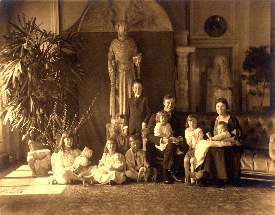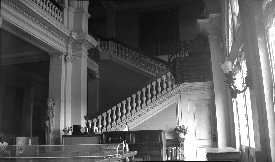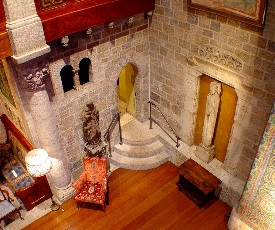The Role of the Pitcairn Collections in the Decision to Build Glencairn
Ed Gyllenhaal and Brian D. Henderson
Glencairn Museum News 27.2 (2005): 1–3.
This 1923 family photograph taken in Cairnwood's hall shows a mixture of sculpture, which, however carefully arranged, looks out of place in its 19th century Beaux Arts architectural surroundings. The fireplace with its elaborate French mantle is covered with a curtain to provide a backdrop for an arrangement of three medieval sculptures. Photo: Raymond and Mildred Pitcairn Archives. Click on image for a larger version.
Glencairn Museum, on the campus of the Academy of the New Church in Bryn Athyn, Pennsylvania, is known internationally as a museum of religious art and history. This 20th century medieval-style castle is nestled between Bryn Athyn Cathedral, a New Church house of worship dedicated in 1919, and Cairnwood, the 1895 Beaux Arts "home in the country" built by New Church philanthropists John and Gertrude Pitcairn. It is well known that Glencairn, completed in 1939, is the former home of John's son Raymond and his wife Mildred Pitcairn, built as a family residence and as a repository for their remarkable collection of religious art. What is less well known is that a portion of this collection was on display in Cairnwood long before ground was ever broken for Glencairn. The difficulties that Raymond encountered in attempting to exhibit his growing collection of stained glass and sculpture at Cairnwood greatly influenced his desire to build an entirely new structure.
Letters and photographs from the 1920s reveal that, while Cairnwood was indeed the Pitcairn family's home at this time, the art collection was not particularly "at home" there. A family photograph taken in Cairnwood's hall in 1923 (above) reveals a heterogeneous mixture of sculpture, which, however carefully arranged, was not appropriate to its 19th century Beaux Arts architectural surroundings.1 A 12th century capital (09.SP.168) rests on the floor near the window, while a 19th Dynasty Egyptian statue of a seated woman2 is positioned so that it blocks the door to the living room. The fireplace is covered with a curtain to provide a backdrop for an arrangement of three medieval sculptures: the life-sized 13th century statue of St. Paul stands atop a 12th century capital showing Christ flanked by lions, both situated beneath an 11th century tympanum in low relief.3
A photograph from the 1930s includes a view of the famous "slim princess" a 12th century French statue-column thought to represent the Queen of Sheba (09.SP.103). The queen is not shown to best advantage, being tied to a column in the hall with a piece of wire, just behind the ping-pong table.
The famous "slim princess," a 12th century statue-column thought to represent the Queen of Sheba, from the church of Saint-Thibaut, Provins. Here shown in Cairnwood's hall in the 1930s, it is tied to a column with a piece of wire, just behind a ping-pong table. Photo: Raymond and Mildred Pitcairn Archives. Click on image for a larger version.
The queen's new home in Glencairn's great hall, enclosed within a 12th century portal. Photo: Christopher Smith, TDI Productions. Click on image for a larger version.
As difficult as it was for Pitcairn to find satisfactory ways of displaying his sculptures in Cairnwood, the situation with regard to his stained glass collection was even worse: "It is quite a problem to find a place to put this glass up even temporarily to obtain a good view of it" (December 11, 1922).
In fact, just a year after his debut as an art collector at the Lawrence sale in New York City (where he bought an important collection of medieval stained glass, including the priceless "King Window"), Pitcairn was already considering how to provide a proper setting for his growing collection. In January of 1922, he writes to his brother Theo:
One of the most striking differences between art of the past and that of today is the fact that the ancient art objects were not isolated things which were more or less forced into their surroundings, they were part and parcel of the temple, the acropolis, the house or tomb for which they were made. Our private collections as well as our museums are full of things which do not really fit their surroundings and with the introduction of oil painting on canvass, art became more and more divorced from its proper relation to the living conditions of the people. Of course beautiful things can be done where an artist understands what he is about. Barnard's cloister stands head and shoulders above the private and museum collections because his objects were made part of the building which he built them into.
I should like, one day, to incorporate my little collection into a studio which would be a Romanesque or early Gothic room or small building, but after all the more important work is the production of something new. The collector's work is interesting but it is far easier than productive work. (January 12, 1922)
The above passage represents the first known mention of Pitcairn's idea of building "a Romanesque or early Gothic room or small building" to house his collection (which at this point was still rather small). Pitcairn mentions the idea in at least six more letters that year (1922), sometimes in the context of acquiring more objects for the building that would later become known as Glencairn.4 In one letter he calls it "my little cloister studio" (June 1, 1922). At this point Pitcairn's interest in "Barnard's cloister" and his desire to build something along similar lines for himself, was beginning to influence his collecting activities. This is clear in a letter written six weeks later to Henri Daguerre, the Parisian art dealer:
I notice that all of the objects mentioned in your letter are capitals and that only a few of them have columns and bases. I should also like fine bas reliefs, carved columns, fine statuary, also other architectural pieces. A set of fine large capitals that could be used in a series in a building in some such manner as Mr. Barnard has done, would be very useful. (February 27, 1922)
"Mr. Barnard" is George Grey Barnard, who, some eight years earlier, had introduced the idea of incorporating medieval sculptures into the fabric of a building constructed in the medieval style. In 1914, when he opened his Cloisters museum to the public in Manhattan's Washington Heights, Barnard's medieval collection was probably the most extensive of its kind in America. However, it was the innovative way he chose to exhibit his collection that captured the imagination of the public and experts alike. Gone was the customary neoclassical museum setting with its unimaginative style of exhibitry. Barnard's Cloisters was a brick building with an interior resembling a small medieval church, cruciform in shape, including a nave, galleries, a chancel with a high altar, a sacristy and a passage leading to the Cuxa cloister. The collections were incorporated into the fabric of the architecture in an aesthetically pleasing way. As an early guide book observed, "The Cloisters is a shrine, where mediaeval art is not so much on exhibition as at home."5
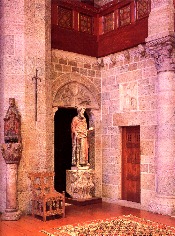 | 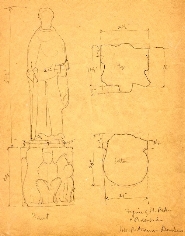 |
This composition of three medieval sculptures in a corner of Glencairn's great hall (with St. Paul in the middle) first appeared in Cairnwood's hall (see top photo). One of Pitcairn's artists sketched and measured the group while it was still in Cairnwood (circa 1931), as part of the process of planning its new home in Glencairn. Before their move to Glencairn, many objects in the Pitcairn collection were displayed at Cairnwood or placed on loan to local museums. Photo (left): Barry Halkin. Photo (right): Raymond and Mildred Pitcairn Archives. Click on the images for a larger version.
Pitcairn met Barnard at the Cloisters in the spring of 1921, and subsequently purchased several medieval sculptures from his collection. His experiences with Barnard's innovative ideas about exhibitry provided Pitcairn with a suitable way to show his existing collection, and guided his purchases for years to come. By June of 1922 he had already chosen the location:
I have some exciting ideas for the cloister studio, which I shall probably build on the flat piece of ground toward our rear entrance, near the group of pine trees and evergreens. (June 6, 1922)
Before the end of the decade, construction had begun on that spot for Glencairn.
Footnotes top
1 Letters and photos are in The Raymond and Mildred Pitcairn Archives, Glencairn Museum, Bryn Athyn, PA.
2 This statue depicts Enehy, a 19th Dynasty (c. 1307–1250 B.C.) Chantress, or temple musician. It is mentioned by Georg Steindorff in his 1942 article, "Two Egyptian Statues of the Ramessid Period" (Journal of the Walters Art Gallery, 9–17). Steindorff refers to the Reverend Theodore Pitcairn of Bryn Athyn, PA (Raymond Pitcairn's brother), and it may be that when the Cairnwood photo was taken the statue was on loan to Raymond from Theodore. The present writer does not know when the statue left the possession of Theodore, but it was purchased at a Christie's auction in London on July 6th, 1976, by the Matsuoka Museum in Tokyo. The Walters Art Museum in Baltimore, MD, owns an almost identical statue of Enehy, presumably from the same tomb (22.106).
3 See 09.SP.127, 09.SP.126, and 09.SP.128, Glencairn Museum. The composition of these three sculptures, however, must have appealed to Pitcairn, as the arrangement was retained for Glencairn's great hall. (See photo and sketch, above.)
4 See the following letters in The Raymond and Mildred Pitcairn Archives, Bryn Athyn, Pennsylvania: Raymond Pitcairn to Henry Daguerre, 27 February 1922; Raymond Pitcairn to A. Kingsley Porter, 1 June 1922; Raymond Pitcairn to Lawrence Saint, 6 June, 1922; Raymond Pitcairn to Jacques Seligmann, 3 October 1922; Raymond Pitcairn to T. M. Legge, 12 October 1922; Raymond Pitcairn to Richard Melchers, 11 December 1922.
5 Joseph Breck, The Cloisters: A Brief Guide (New York: The Metropolitan Museum of Art, 1926), 4, 6. In the 1930s Barnard's collection was moved to its present location in Fort Tryon Park, overlooking the Hudson.
Revised 12/7/2005
